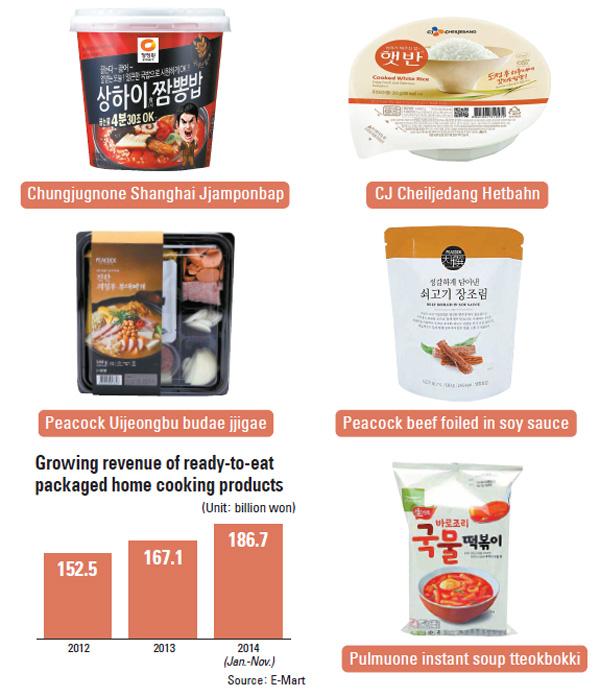Ready-to-eat finds a place at table

The perception had always been that processed and prepackaged food was lacking in taste and quality. But to her surprise, not only was the flavor convincing the ingredients were plentiful.
“Jjigae takes a lot of time to make, but this ready-to-eat packaged jjigae is as good as homemade, so we keep buying it,” Park said.
And she’s not the only one.
Sales of ready-to-eat food products are growing rapidly, especially those that are staples of Korean households. As they are already cooked and packaged, consumers need only to add boiling water.
Until now, such products have been largely limited to three-minute curry, but the choices are becoming more diverse.
According to a report by Nielsen Korea, overall sales of food products at E-Mart, Lotte Mart and Homeplus shrank 5 percent year-on-year in May. During the same period, frozen ready-to-eat sales jumped 6 percent.
During the first 11 months of the year at E-Mart, ready-to-eat product sales increased 11.7 percent year-on-year to 186.7 billion won ($168.2 million).
Market experts say this is largely because today there are more single households and households where both the husband and wife work.
As a result, food companies have been busy coming up with more simple and more convenient food products that replace home cooking.
E-Mart’s precooked packaged food brand Peacock offers 500 items that include Korean jjigae and other side dishes, as well as Indian and Vietnamese dishes.
The marketing goal is to stand out by providing a greater variety of food than the competition. The Peacock brand includes japchae, stir-fried noodles with mixed vegetables, and buljokbal, steamed pork legs marinated in extremely hot pepper paste.
The marketing worked, and last month Peacock’s sales surged 67.3 percent year-on-year.
“We have been cooperating with the famous Korean restaurant Samwon Garden in releasing ready-to-eat galbitang, hot beef rib soup, and working with the famous restaurant in Daegu, Songrim, in introducing ready-to-eat daegutang, or codfish soup,” said an E-Mart official. “We were able to gain customers’ trust with the packaged food as we strictly followed the recipes of these restaurants.”
The enhanced quality of ingredients going into ready-to-eat packaged food is another reason many consumers are now buying these products to place them on their dinner table.
But products with more generous ingredients are slapped with a “premium” label and price tag.
Food company Ourhome offers a 300-gram yukgaejang, or spicy beef soup, for 2,100 won. The premium version is 4,500 won for a 500-gram package. Although more expensive, the premium version is more popular.
Microwavable instant rice products like CJ Cheiljedang Hetbahn continues to gain wide popularity. In the first 11 months of this year, Lotte Mart sales of such rice surged 54 percent.
Chungjungone, which last year got raves for Cup Gukbap instant rice soup, has been busy producing four new similar products, including Shanghai Jjamppong Rice Cup.
Last year, the food company sold 5 billion won worth of such products. This year, the company expects sales to reach more than 10 billion won.
“Our food research department is spending countless hours in developing extraordinary products that will create a niche market even in the precooked ready-to-eat food industry,” said a Chungjungone official.
BY PARK MI-SO [ojlee82@joongang.co.kr]










with the Korea JoongAng Daily
To write comments, please log in to one of the accounts.
Standards Board Policy (0/250자)